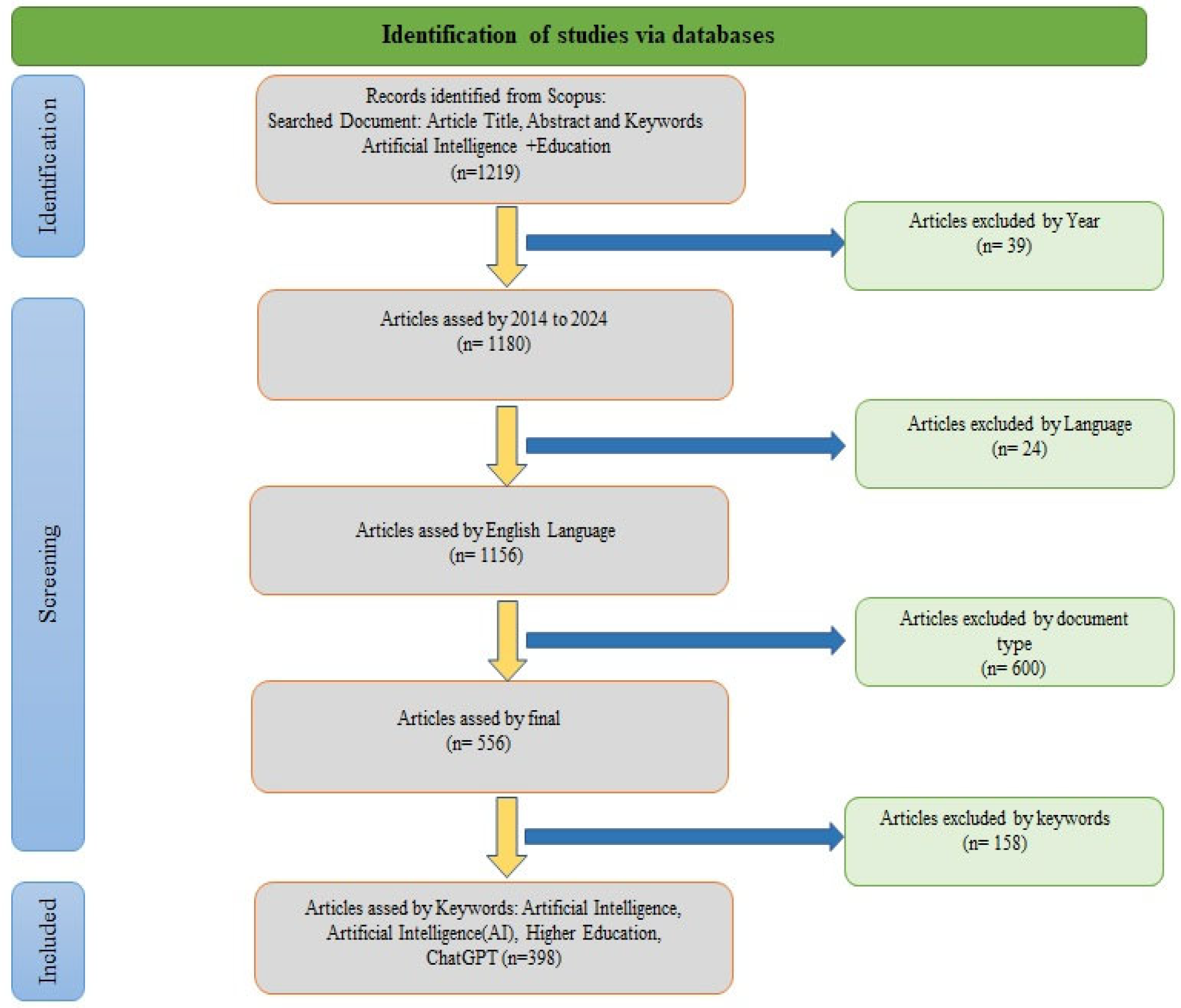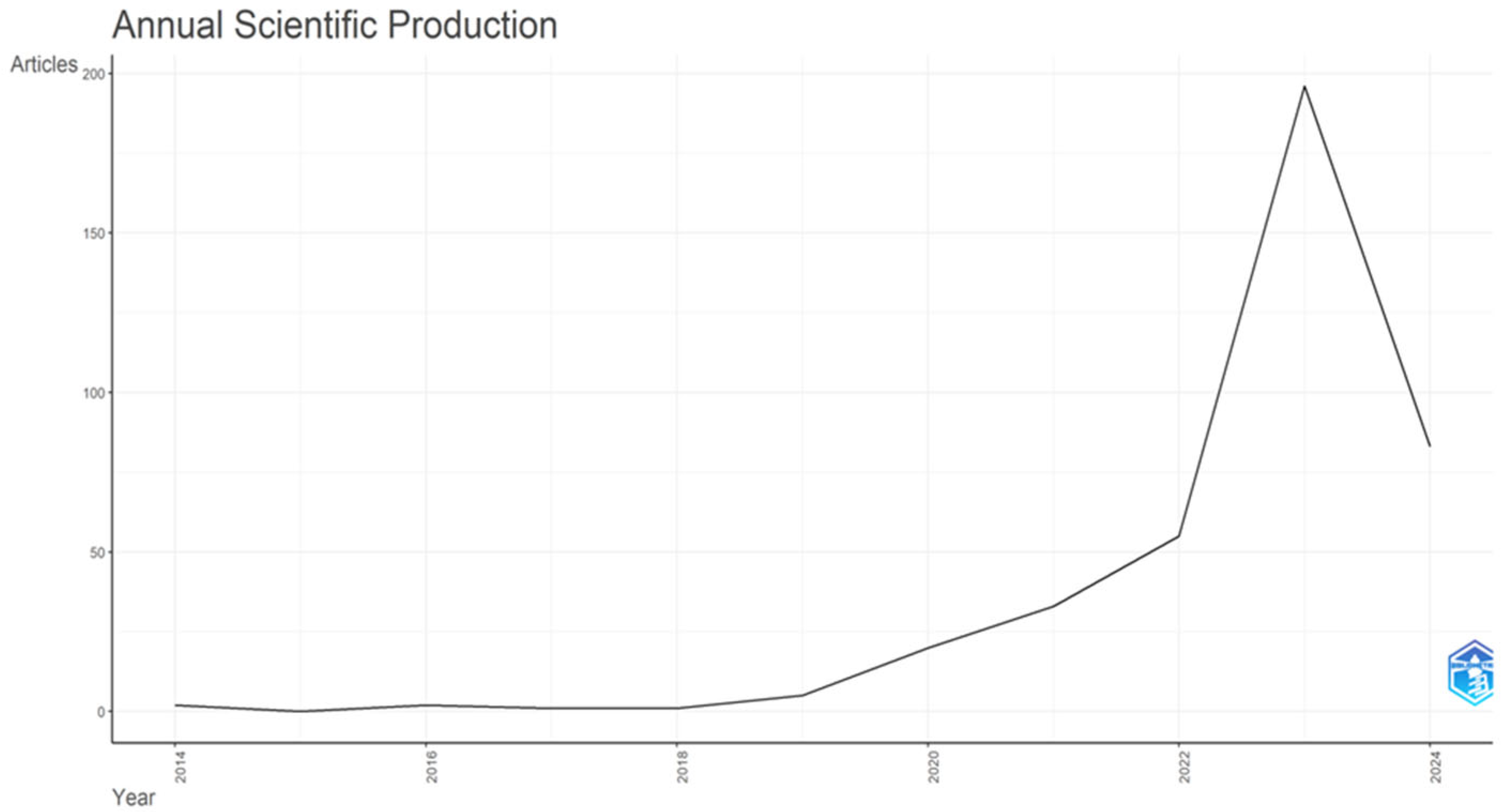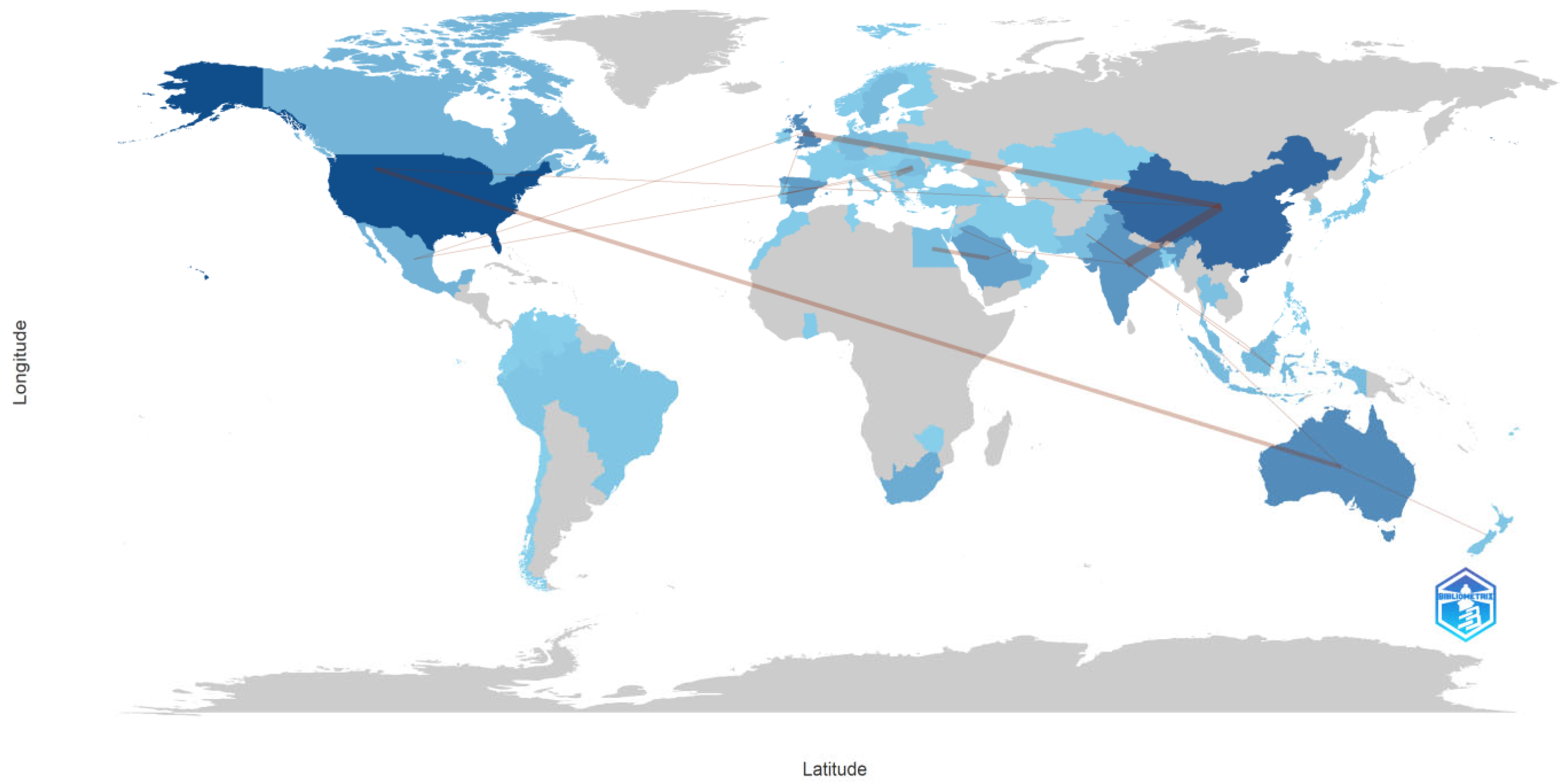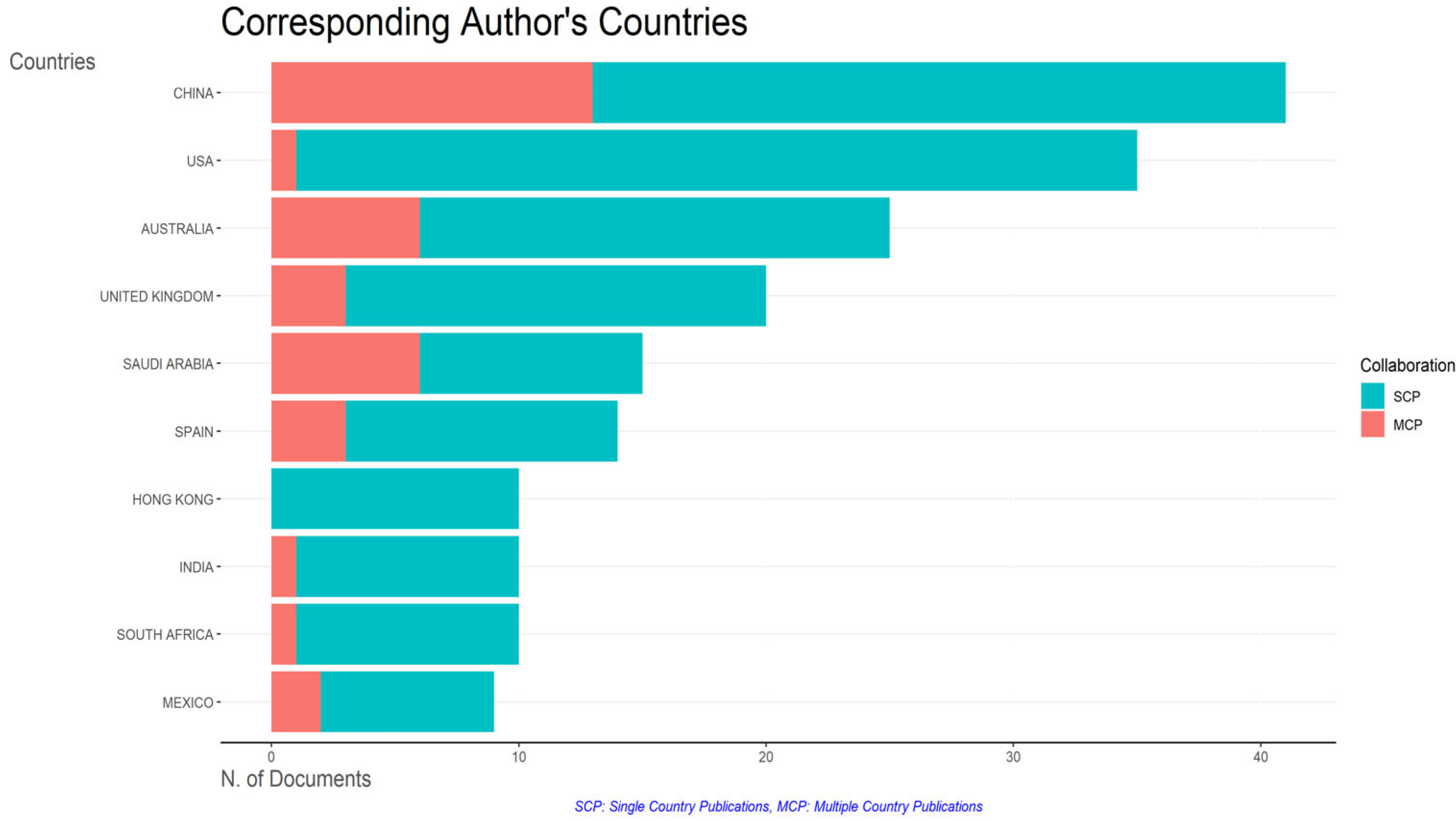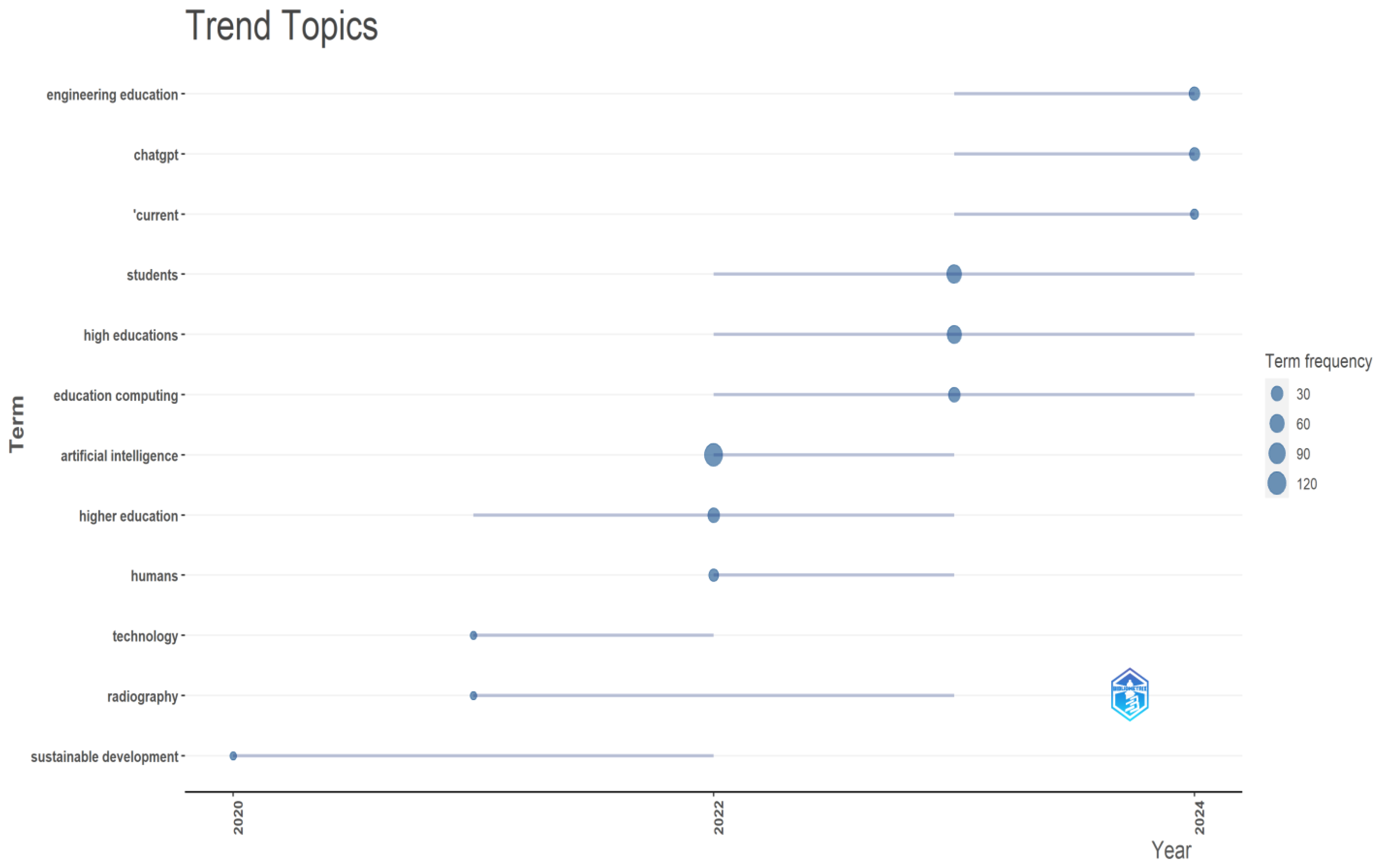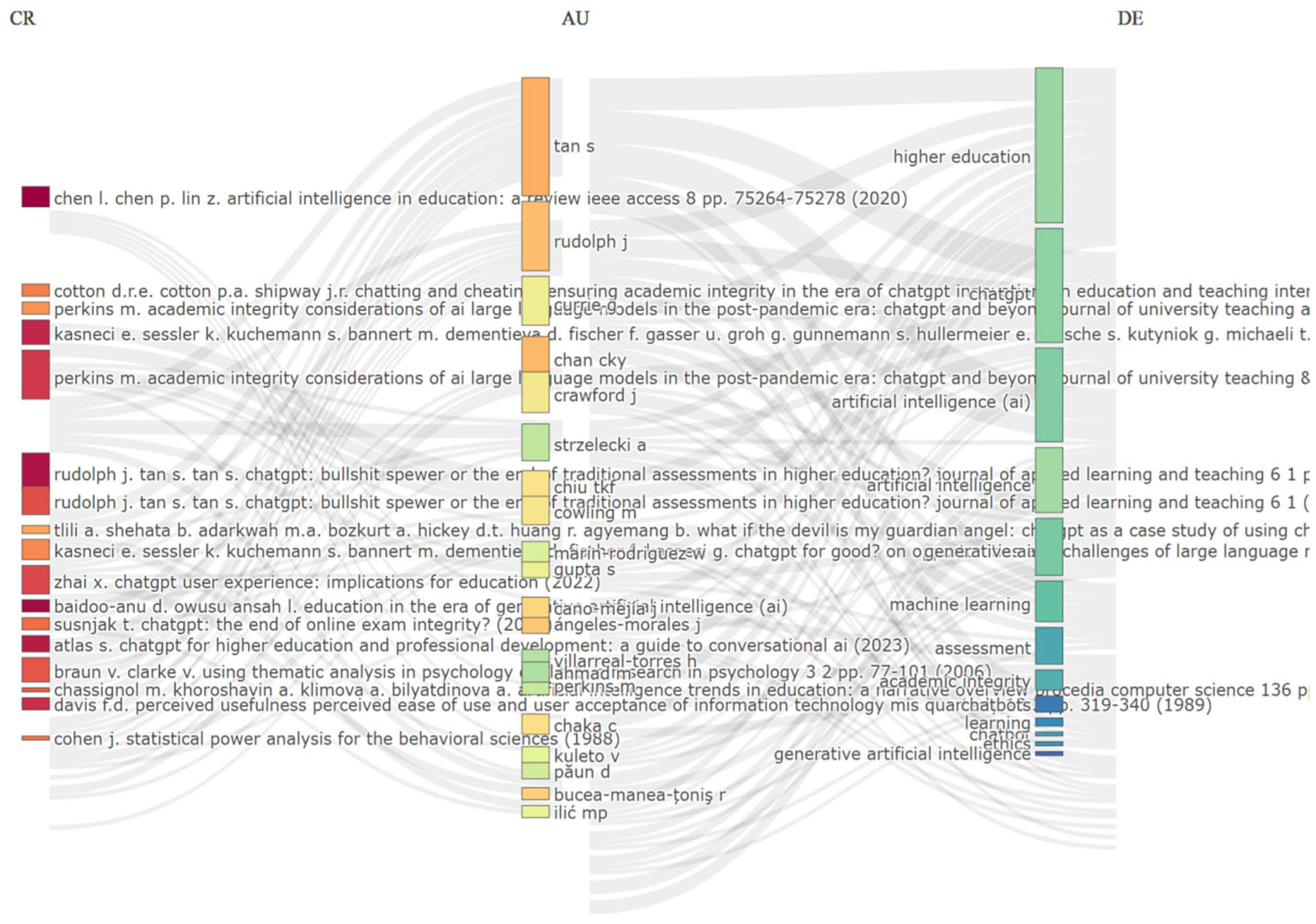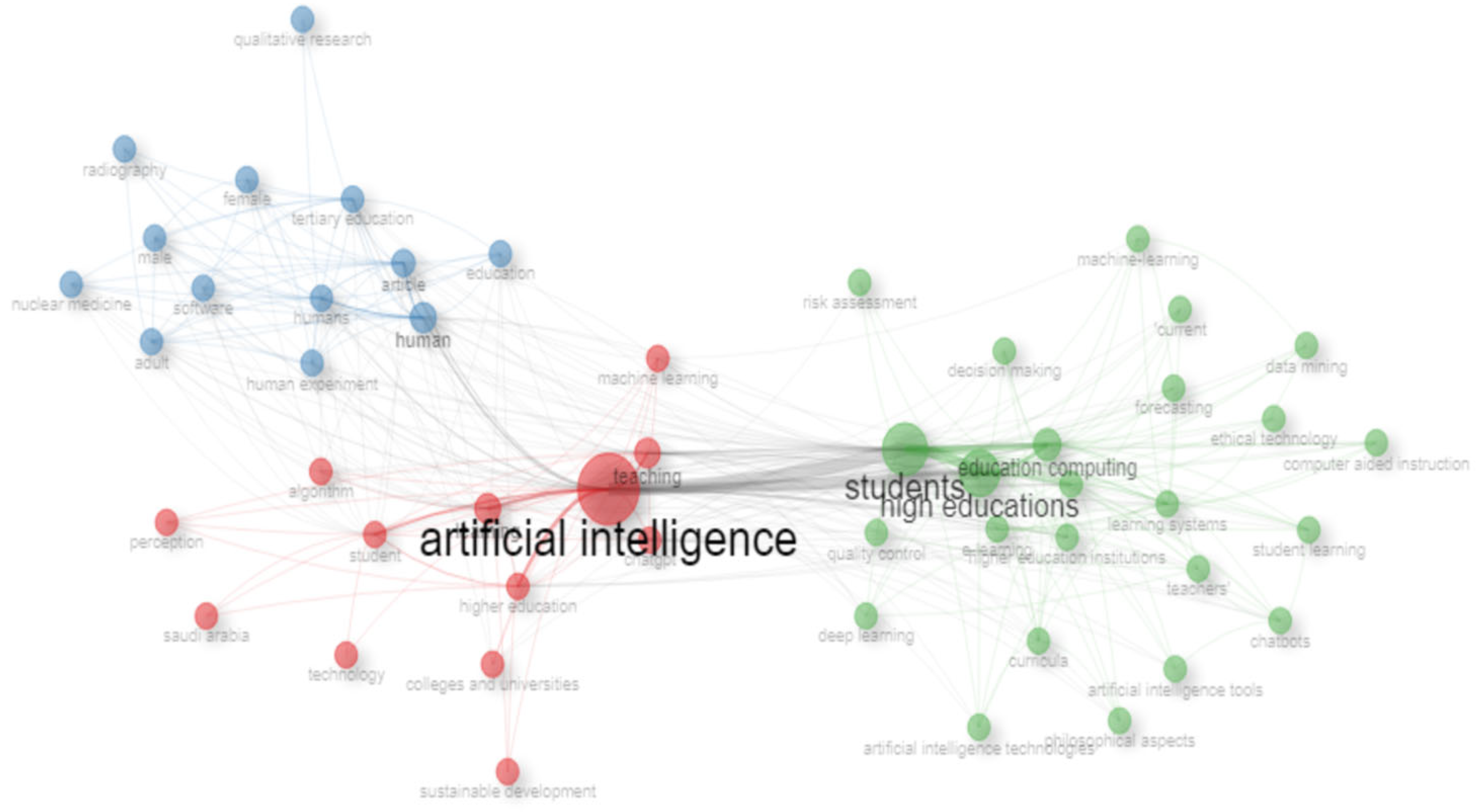1. Introduction
The rapid advancement of artificial intelligence (AI) has reshaped various domains, including higher education in a transformative era [
1]. As universities strive to maintain academic excellence and embrace innovative pedagogies, the integration of AI has become increasingly prominent. The objectives of AI integration include creating tools capable of reasoning, learning, making decisions, and adapting to new situations similarly to humans [
2]. This evolution has changed traditional teaching methodologies and introduced novel approaches to learning, from intelligent tutoring systems and personalized learning to automated grading and plagiarism detection [
3].
In education, the prominent AI applications include educational data mining (EDM), learning analytics (LA), and machine learning (ML). The conventional educational model, which treats all learners the same, is being replaced by AI-driven precision learning. This method accounts for individual differences and learning environments to better predict student performance and timely intervene to enhance the learning experience [
4,
5]. Baek et al. [
5] emphasized that AI enables personalized and precision learning, identifying the optimal time for learning based on individual learner characteristics.
The implementation of AI in education relies heavily on big data—vast and complex datasets representing human behavior that demand advanced tools for processing. Such data are generated by devices including scanners, mobile phones, cameras, and social media platforms [
6]. Traditional methods for managing data are insufficient for handling these large and varied datasets, prompting big data analytics to collect, analyze, and evaluate this complex information [
7]. However, in many developing countries, the implementation of AI-driven applications is hindered by challenges such as inadequate infrastructure, limited access to technology, absence of supportive policies, and insufficient data science expertise.
In the present bibliometric study, we delved into the burgeoning landscape of AI applications in higher education, meticulously analyzing the trends, patterns, and dynamics that have unfolded between 2014 and 2024. The methodology encompasses rigorous data collection from the Scopus database adhering to well-established protocols [
7,
8]. By scrutinizing publication patterns and citation networks, the intellectual landscape can be found to establish a solid foundation for future research [
9]. The results of this study contribute to the growing body of knowledge on AI applications in higher education, offering additional data on prevailing trends and pioneering initiatives. Second, it serves as a valuable reference for policymakers, administrators, and educators seeking to devise strategic plans for seamless AI integration within their institutions. Third, the results highlight research gaps and opportunities, stimulating further exploration and innovation in education [
10].
Building upon previous study results presented at a conference [
6], additional tools were used to evaluate key contributors, emerging trends, and significant focus areas in AI research. A surge in publications related to AI in higher education was observed, reflecting heightened interest and investment in this transformative technology. Prominent themes have emerged, such as adaptive learning systems, AI-powered assessment tools, and ethical considerations surrounding AI implementation [
11]. In addition, interdisciplinary collaborations and international research networks have played a pivotal role in advancing this field, underscoring the global significance of AI in academia.
Most research on AI in higher education was conducted in developed nations, while the field is still emerging in many developing regions. The successful integration of AI in higher education is key to driving socioeconomic development, as AI technologies are increasingly deployed across industries and organizations. Therefore, we explored the primary areas of focus for AI research in higher education between 2014 and 2024, identified countries and publishers contributing to the related studies, and emerging research topics in AI usage in higher education.
By unraveling the intricate tapestry of scholarly activity, this study aims to provide an understanding of the AI revolution in academia. By analyzing influential publications, authors, institutions, countries, emerging trends, and research topics, the future of AI in higher education can be reshaped. Stakeholders can make informed decisions, foster collaborations, and propel innovation in pursuit of academic excellence based on the results of this study.
2. Literature Review
The educational landscape has embraced a constructive learning paradigm, where students actively participate in knowledge construction while teachers provide guidance [
12,
13]. The scope of AI in education encompasses Fuzzy logic, decision trees, neural networks, Bayesian networks, and hidden Markova models [
14]. These technologies are extended to deep learning, machine learning, and natural language processing [
15], manifesting practical applications such as chatbots, expert systems, and intelligent tutoring systems [
16]. The foundation for these advancements is the vast amounts of data generated by mobile technologies, online learning platforms, learning management systems, and massive open online courses [
7,
17].
A prominent theme in the literature is AI’s potential to personalize learning experiences through intelligent tutoring systems and adaptive learning environments tailored to individual student needs [
18]. Hwang et al. [
18] improved decision-making and enhanced student performance as key benefits. Educational data mining (EDM) has been used for pattern identification and behavior analysis to enhance learning outcomes [
19,
20], while predictive analytics play a crucial role in detecting learning patterns and enabling early interventions for at-risk students [
21].
AI assists educators with various administrative tasks, including grading, plagiarism detection [
22], and identifying at-risk students for interventions [
23]. AI algorithms analyze data for admissions, curriculum design, and resource allocation [
24]. The automation of assessment processes using AI algorithms has revolutionized educational workflows, streamlining traditionally time-consuming tasks [
25]. Dialog systems or chatbots function as pedagogical agents [
26], assisting with student registration processes [
11] and handling routine questions in online forums [
27].
LA represents another significant advancement, involving the collection and analysis of student data to enhance learning environments [
24]. LA is used to predict student performance and optimize learning contexts [
28]. Prahani, Binar et al. [
29] introduced precision education (PE), an approach based on extensive data analysis that aligns with constructivist learning principles and uses historical data for timely interventions [
30]. In higher education specifically, Binar et al. [
29] collected and analyzed big data using digital tools for informed decision-making, highlighting how big data support personalized learning. Recommender systems have improved learning outcomes [
30], particularly in course selection, with accuracy rates exceeding 90% [
31]. The development of advanced thinking skills using deep learning was explored, highlighting how students absorb and apply knowledge using analogy [
31]. Binar et al. [
29] analyzed intelligent learning systems that consider various student factors to provide tailored educational experiences.
While AI offers numerous benefits, various challenges and considerations were identified. Ethical concerns around data privacy, algorithmic bias, and displacement of human educators were highlighted [
32]. The importance of professional development for educators to effectively integrate AI was emphasized [
16], as well as continuous monitoring of AI systems for efficacy, fairness, and alignment with educational goals. Bibliometric studies have contributed to the understanding of AI in education. Rodgers et al. [
33] revealed research trends in AI in high school education, while Rodgers et al. [
33] examined AI’s roles in mathematics education. Rudolph et al. [
34] presented a comprehensive review of AI in education research over the last ten years, highlighting evolving themes and research fronts. Rudolph et al. [
34] conducted a bibliometric analysis of worldwide educational AI research development over the past two decades, providing a broader temporal perspective. Rodgers et al. [
33] assessed AI’s impact on scientific literature in higher education, while Rudolph et al. [
34] explored the adoption of the Internet of Things (IoT) and AI technologies in education using a systematic literature review with a bibliometric meta-analysis. Interdisciplinary and international collaborations have significantly advanced AI research in education [
4,
19]. Through the literature review, we explored various emerging areas, including AI’s impact on pedagogy, instructional design [
35,
36], and online/distance education [
37]. The integration of AI technologies in education has presented a significant evolution in teaching and learning methodologies, supported by robust research and practical applications. The importance of balancing innovation with responsible implementation was emphasized to enhance academic excellence.
3. Methods
Data Collection
The data source for this study was the Scopus database, widely recognized as a repository of peer-reviewed literature across multiple disciplines. The search query was constructed using keywords such as “artificial intelligence”, “higher education”, “university”, “academic”, and their variations. The initial search yielded a total of 1219 publications spanning the specified period from 2014 to 2024. To ensure the relevance and quality of the data, filtering and screening were applied. To ensure the reliability and reproducibility of the analysis, protocols and best practices in bibliometric research were followed (
Figure 1) [
38,
39,
40].
Figure 1 depicts a “preferred reporting items for systematic reviews and meta-analyses” (PRISMA) flow diagram, which is widely used for presenting the study selection process in systematic reviews and meta-analyses. The PRISMA flow diagram offers a transparent depiction of the study selection process, illustrating the number of records identified, screened, and included or excluded at each stage. These data are vital to evaluate the thoroughness and repeatability of the systematic review or meta-analysis.
In the identification stage, followed by the screening stage, records were filtered based on the publication year, resulting in 1180 articles. Next, the articles were screened based on the language, and 24 articles were excluded for different languages, leaving 1156 articles. Further screening was conducted based on the document type, and 600 articles were excluded, as they were non-research articles, such as Editorials, book reviews, or conference proceedings. After screening, 556 articles remained for inclusion in the study. In the inclusion stage, additional keyword filtering was applied, and 138 articles were excluded, leaving 418 articles for the final analysis. The final set of included articles was assessed by considering the keywords “artificial intelligence”, higher education”, and “ChatGPT (n = 398)”.
4. Results
The Biblioshiny tool from RStudio 2024 was used to analyze AI in higher education. This method was used to examine keywords, journals, and statistics to identify emerging areas [
39]. By leveraging bibliometric analysis, influential publications, and collaborative networks were identified.
4.1. Descriptive Analyses
Table 1 presents the characteristics and metrics associated with AI in higher education articles, offering data on their academic impact and collaboration patterns. In total, 398 documents were analyzed, originating from 226 sources, including journals, books, and other scholarly materials. Within these documents, 1099 keywords (ID) and 1187 author keywords (DE) were identified. This diversity of keywords indicated the multifaceted nature of the research topics and the various perspectives of the authors. The number of 1211 authors underscored the collaborative nature of academic inquiry, as scholars from diverse backgrounds and institutions contribute their expertise to the discourse.
While a significant portion of the documents were written by multiple authors, 79 single-authored documents were identified. The balance between collaborative and individual contributions highlighted the range of scholarly endeavors presented in the dataset. Additionally, the average number of citations per document of 8.693 suggested an impact on the academic community, reflecting the relevance and significance of the research findings. The international dimension of collaboration was revealed as 22.86% of co-authorships were from different countries. This international collaboration showed the global nature of academic research and the interconnectedness of scholars across geographical boundaries. Moreover, an annual growth rate of 45.15% indicated a dynamic and evolving landscape of scholarship, with new research contributions emerging at a rapid pace.
4.2. Annual Publication Growth
Figure 2 presents the annual scientific growth until 23 April 2024, depicting the evolution of publications. Notably, 83 articles were published in 2024, reflecting substantial growth in a quarter of the year. The results revealed a progressive trend over the years, with notable spikes in 2020, 2021, and 2023. These peaks indicate significant research output, potentially influenced by technological advancements or heightened scholarly activity. In 2015, no publications were found while subsequent years showed a resurge, demonstrating the resilience of the academic community. The results showed the dynamic nature of scientific inquiry and the ebb and flow of research productivity over the years, with 2024 poised for considerable growth.
4.3. Highly Cited Articles
The top 20 list of articles and the number of citations are shown in
Table 2. The most influential article was “Bullshit spewer or the end of traditional assessments in higher education?” authored by Rudolph et al. published in the “
Journal of Applied Learning and Teaching” in 2023 with 218 citations. They analyzed conventional assessment methods in higher education and explored the potential of AI technologies to revolutionize assessment practices, sparking discussions on innovative approaches to evaluating student learning. Another article was “Chatting and cheating: Ensuring academic integrity in the era of ChatGPT” authored by Cotton et al. [
11] This article, published in “
Innovations in Education and Teaching International” in 2024, had 193 citations. It addressed critical concerns surrounding academic integrity in the context of emerging AI technologies such as ChatGPT, offering strategies for maintaining integrity amidst technological advancements.
Table 2 exhibits the combined citations from individual and collaborative authors, in descending order. These top-cited articles signified their pivotal role in shaping scholarly discourse and guiding future research endeavors in the field of AI in education.
4.4. Productive Sources
Table 3 outlines productive sources contributing to the discourse on AI for academic excellence in higher education from 2014 to 2024. “
Sustainability (Switzerland)” published 18 articles, followed by the “
Journal of Applied Learning and Teaching” with 15 articles. “
Education and Information Technologies” and “
Education Sciences” published 13 articles each, indicating their significant contributions to the field. “
Computers and Education: Artificial Intelligence” and the “
International Journal of Educational Technology in Higher Education” published 10 articles, respectively. Other influential publications included the “
International Journal of Emerging Technologies in Learning” with seven articles and the “
Journal of University Teaching and Learning Practice” with six articles. These sources shaped discussions and advancements in the integration of AI technologies within higher education.
4.5. Contributing Authors
Table 4 outlines author productivity and citation statistics, showcasing their contributions to scholarly discourse. Tan S. had seven publications and a total citation number of 683, averaging 341.5 citations per year (TCpY). Chan C. K. Y. and Rudolph J. had four publications and notable citation counts of 58 and 343, respectively. Cowling M., Crawford J., and Currie G. demonstrated significant contributions with three publications, respectively. Bucea-Manea-Ţoniş R. and Cano-Mejía J. had fewer publications but showed noteworthy impacts. The results underscored the diverse contributions and varying levels of impact among authors in the academic realm, reflecting their roles in advancing knowledge within their fields.
4.6. Productive Countries
Table 5 presents the production of articles and citation statistics across various countries. The United States had 153 articles and a total citation number of 311. The United Kingdom follows with 400 citations from 82 articles. China, despite producing 103 articles, ranked third in total citations with 311, indicating a lower average citation rate. The Netherlands and Serbia stood out with exceptionally high average article citation rates of 60.30 and 43.30, respectively. Turkey and Vietnam demonstrated notable citation rates, indicating an impact on research outputs.
Figure 3 presents collaboration patterns between countries based on the frequency of collaborations. Australia and New Zealand, Australia and Singapore, and China and India have cooperated closely in different years. Canada and Portugal, and India and Bahrain demonstrated cross-continental research initiatives. These collaborations indicated a global exchange of knowledge and resources, fostering international partnerships to address research challenges and advance scientific endeavors.
4.7. Corresponding Author’s Country
Table 6 and
Figure 4 show the most relevant countries based on the corresponding author’s affiliation in academic articles. China published 41 articles, with 13 single-country publications (SCPs), yielding a multiple-country publication (MCP) ratio of 0.317. The USA published 35 articles with an MCP ratio of 0.029. Australia published six articles with an MCP ratio of 0.24. Notably, Saudi Arabia showed an MCP ratio of 0.4, indicating productivity with 15 articles. Spain, India, and South Africa also exhibited high MCP ratios, reflecting their active involvement in research. The results underscored the global collaboration and diverse geographic contributions in academic research endeavors.
4.8. Keywords
Figure 5 and
Table 7 present the frequency of key terms in academic discourse related to education and technology. “Artificial Intelligence” dominated with 328 occurrences, indicative of its role in reshaping educational paradigms.
“Students” appeared 152 times, reflecting a focus on student-centered approaches. “High education” and “Higher Education” appeared 115 and 79 times, respectively. “Learning” and “Teaching” showed 70 and 60 occurrences, respectively. “Education Computing”, “Engineering Education”, and “E-learning” denoting the intersection of technology and education appeared in varying frequencies. These patterns suggested a concerted effort to leverage technological advancements, particularly AI, to enhance teaching, learning, and educational practices in higher education.
Figure 6 depicts topics with their frequencies and years of prominence. “Artificial intelligence” was a consistently trending topic, peaking in 2022 and maintaining relevance using 2023.
The appearance of “students” and “high education” appeared the most from 2022 to 2024. “Education computing” also exhibited a rising trend, reflecting the increasing integration of technology in education. “Higher education” demonstrated consistent relevance, with a slight decline after 2023. “Engineering education” and “ChatGPT” gained prominence from 2023 to 2024. “Humans” and “sustainable development” most appeared in 2022 and 2020, respectively. A dynamic landscape with evolving interests and emerging areas of focus was observed in the intersection of education and technology.
4.9. Three-Field Plot
Figure 7 shows a three-field plot with country/region (CR), author (AU), and document (DE). AU contained author names such as “tan s” and “rudolph j” most, indicating the authors published research articles related to AI in higher education. CR showed the country or region associated with the authors or publications. In this case, “chen l. chen p. lin z.” appeared to be a leading author group. DE displayed terms related to the documents or publications. “Higher education” was prominently displayed, suggesting that many publications focused on the application of AI in higher education settings.
The lines connecting the entities across the three fields represent the relationships between them. For example, the line connecting “chen l. chen p. lin z.” (CR) to “artificial intelligence in education: a review IEEE access 8 pp. 75264–75278 (2020)” (DE) indicates that this publication is authored by the group from a specific country or region. Additionally, the thickness of the lines and the size of the labels indicate the strength or importance of the relationships or entities. Thicker lines and larger labels present more frequent or significant connections or entities. The three-field plot provides a visual representation of the authors, their affiliations or countries/regions, and the publications related to AI in higher education. It allows for the identification of key authors, influential publications, and potential collaborations or research networks within this field.
4.10. Keyword Analysis
Figure 8 illustrates the keyword analysis utilizing term co-occurrence mapping. These keywords either originated from the publication’s title or abstract or directly from the article’s keyword list [
40]. At the center of the network, “artificial intelligence” was represented by a large red node, indicating its high frequency and importance within the dataset. Surrounding the central node, other red nodes represent closely related terms, such as “learning”, “system”, and “development”. Extending outward from the central cluster are two distinct groups of nodes.
The blue nodes on the left represent concepts more closely associated with the technical and computational aspects of AI, such as “neural networks”, “data”, “model”, and “algorithm”. This cluster highlights the underlying technologies and methodologies involved in AI research and applications. On the right side, the green nodes represent concepts related to the educational context and application domain of AI. These nodes include terms like “students”, “high education”, “education computing”, “learning environments”, “computer instruction”, and “intelligent tutoring systems”. This cluster reflects the focus on integrating AI technologies into educational settings, teaching practices, and learning experiences. The connections between the nodes, represented by lines, indicate the co-occurrence of keywords within the literature. Thicker lines signify stronger co-occurrence relationships, suggesting that the connected terms frequently appear together in the same documents or publications.
5. Discussion
By utilizing bibliometric review analysis, the literature on AI in higher education was presented. After analyzing 398 relevant articles from the past decade, the contributing author’s multifaceted nature and varied perspectives were found. The annual growth rate was 45.15%, indicating a dynamic and evolving landscape of research on AI usage in higher education. This trend was also observed in the annual publication growth analysis, compared with publications from 2015 to 2018. In 2020, 2021, and 2023, a resurgence was observed, demonstrating resilience and momentum within the academic community indicating a significant stride in research output, which was influenced by technological advancements. Therefore, this pattern presented the dynamic nature of scientific inquiry, showcasing the rise of research productivity over the years, with 2024 poised for considerable growth.
The top 20 articles garnered a high volume of citations. The top three were published by Rudolph et al. [
34] on AI technology-based approaches to evaluating student learning with 218 citations, by Cotton et al. [
11] on the influence of ChatGPT on academic integrity with 193 citations, and by Farrokhnia et al. [
45] on ChatGPT implications for education practice with 136 citations. These studies focused on key aspects of higher education significantly influenced by AI, capturing the attention of researchers in this field. Similarly, contemporary researchers notably cite other studies (
Table 2). The aspect of these studies was related to the AI’s role in personalized learning, academic integrity, learner assessment, and teaching practices. Overall, this trend reflected the importance of AI in transforming higher education and the need for further research on its ethical, practical, and pedagogical implications.
Moving forward, the most productive sources from 2014 to 2024 were the journals
Sustainability and
Journal of Applied Learning and Teaching with the most significant number of articles on the discourse on AI for academic excellence in higher education (
Table 3). These sources reflected the interdisciplinary nature of AI research in higher education, bridging gaps between technology, sustainability, and academic innovation.
In the subsequent analysis of the high contribution list of the top 10 authors, Tan S. and Rudolph J.’s [
34] articles showed many citations, indicating their noteworthy contribution to the field. Other authors, including Cowling M., Crawford J., and Currie G., demonstrated significant contributions with three publications each and respectable citation counts (
Table 4). These authors had diverse disciplines including engineering, technology, psychology, and education.
AI’s broad impact across various fields was confirmed by the results. This interdisciplinary perspective enriched the discourse on AI’s role in education, encouraging collaboration to develop more effective, AI-driven solutions for educational challenges. However, this trend was mainly observed in developed countries, as evidenced by the analysis of author affiliations (
Table 5) and corresponding author countries (
Table 6). A large number of articles with large citation counts were published by countries such as the United Kingdom, USA, China, Australia, the Netherlands, Serbia, Turkey, Hong Kong, Vietnam, and Germany, and a few from India, South Africa, and Mexico. The effects of technological advancements, rapid transition to AI adoption, and diverse geographic collaborations contributed to the production of notable research from these nations. Specifically, authors from diverse regions and disciplines contributed to the development of AI-higher education literature using their perspectives and findings [
41,
42] which were presented on the three-field plot (
Figure 7).
Out of the top 10 keywords, “Artificial Intelligence”, “Students”, and “High educations” appeared most indicating their high relevance to the context of the role of AI in higher education. “Artificial intelligence”, “students”, and “high education” increasingly appeared from 2022 to 2024. “Engineering education” and “ChatGPT” were emerging topics, gaining prominence from 2023 to 2024 (
Figure 6). The co-occurrence network revealed three clusters signifying that studies were mainly conducted on “artificial intelligence”, “learning”, “system”, and “development” indicating the studies were related to AI’s interventions in transforming the higher education system. Close associations were observed between “neural networks”, “data”, “model”, and “algorithm” indicating AI-associated technologies such as machine learning, big data analytics, and neural networks were applied to explore the implications of AI in higher education [
43]. “Students”, “high education”, “education computing”, “learning environments”, “computer instruction”, and “intelligent tutoring systems” indicated the research focused on integrating AI technologies into education, teaching practices, and learning experiences. The results provide a basis for studying unexplored associations (
Figure 8). Overall, a dynamic landscape with evolving interests and emerging areas of focus in the intersection of education and technology was identified.
6. Future Research
The study provided comprehensive analysis results of 398 documents published between 2014 and 2024 on the scholarly discourse related to AI in higher education using bibliometric analysis and the Biblioshiny tool. In total, 226 sources revealed a diverse range of platforms shaping discussions on AI in academia. This diversity prompted questions about the quality and impact of these sources, suggesting future research to identify key journals or publications driving the field forward.
Overall, 1099 keywords (ID) and 1187 author’s keywords (DE) were identified in this study. Keyword clustering or topic modeling needs to be used to uncover hidden themes and connections within the dataset, enriching the understanding of the multifaceted nature of AI in higher education. Citation patterns indicated an average of 8.693 citations per document, reflecting the impact and influence of the research within the academic community. Further investigation of frequently cited articles and their citation networks will provide data on seminal works and emerging areas of interest, guiding future research directions.
We explored authorship trends, involving 1211 authors and underscoring the collaborative nature of research. Future studies are necessary to delve into authorship dynamics, such as patterns of collaboration and author contributions, to understand the social structure of scholarly networks and their implications for knowledge production. International collaboration played a significant role with 22.86% of researchers from different countries collaborating. It is necessary to explore the impact of cultural diversity and international partnerships on research outcomes and knowledge dissemination to understand the global dynamics of AI research in higher education.
The annual growth rate (45.15%) suggested a rapidly evolving landscape of scholarship. The factors driving this growth, including technological advancements, funding trends, and shifts in educational priorities, need to be explored in detail. Considering the relatively recent body of literature on AI in higher education, with an average document age of 1.4 years, longitudinal studies are required to track the evolution of research themes and methodologies over time. Finally, as the dataset comprised 19,517 references, further studies are necessary to identify citation patterns, influential studies, and intellectual lineages.
7. Conclusions
There is a paradigm shift in higher education driven by the integration of AI into learning processes. Previous studies made significant efforts to study the role of AI in higher education. Prominent themes in the literature are personalized learning, pedagogy, instructional design, online/distance education, academic writing, and academic integrity. Research is being conducted to explore the interventions and transformative impacts that AI introduces to higher education. Hence, there is a need to explore the dynamics of the scholarly landscape. Therefore, we conducted a bibliometric analysis of the research published from 2014 to 2024 sourced from the Scopus database. The search was constructed using keywords such as “artificial intelligence”, “higher education”, “university”, and “academic”, and their combinations yielded a total of 1219 published articles. Subsequently, the PRISMA methodology was employed to select articles that met the discourse surrounding AI in higher education based on factors such as year, language, type of research, and keywords. In total, 398 articles were included in the bibliometric analysis. Various dimensions of the literature, including publication sources, keywords, citation patterns, authorship trends, international collaboration, and annual growth rates, were analyzed using the articles.
The descriptive analysis of the articles revealed the interconnections of scholars across geographical boundaries with increasing annual growth, indicating a dynamic and evolving landscape of scholarship supported by the annual publication growth analysis. Compared with publications from 2015 to 2018, the subsequent years, especially in 2020, 2021, 2023, and 2024, significant research outputs were observed. Therefore, the increase continued, further advancing the discourse on AI’s informativeness role in higher education. The analysis result of citations revealed that research topics concerned with academic integrity in emerging AI technologies such as ChatGPT appeared to maintain the most integrity in technological advancements. Productive sources showed that these publications led to discussions and advancements in the integration of AI technologies into higher education. Additionally, author productivity and citation statistics underscored the diverse contributions and varying levels of impact among authors, reflecting their roles in advancing knowledge. Moreover, the corresponding author analysis result disclosed the author’s diverse contributions to future research endeavors.
Keyword relevance and pattern analysis results presented AI, students, higher education, education computing, learning, higher education, teaching, engineering education, human, and E-learning as the interested keywords of researchers. Author’s concerted efforts were observed to leverage technological advancements, particularly AI, to enhance teaching, learning, and educational practices in higher education. The integrated associations within authors’ affiliations, publications, and keywords were visualized using a three-field plot to identify key authors, influential publications, and potential collaborations or research networks. In addition, the co-occurrence network revealed a high-relevance keywords cluster, a technical and computational cluster, and an education and learning practice cluster. Associations between and within these clusters were revealed to study unexplored associations.
These findings offer references for scholars, practitioners, and policymakers and further investigation into content, methodologies, quality, and impact of sources, keyword clustering, authorship dynamics, longitudinal trends, and citation patterns. The result of this study contributes to an understanding of AI in higher education and future research directions.
